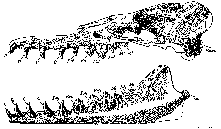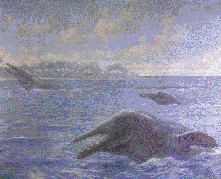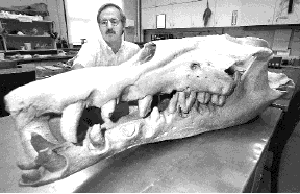| Basilosaurus |
The Mesonychid was a land mammal that spent a good amount of time in the ocean, most likely while eating. They lived probably about 56 million years ago. They had a body much like a Hyena, wolf sized with a small brain. The skull of a Mesonychid is much like that on a bear.
The second ancestor to the Basilosaurus is the Ambulocetus. They lived 37-58 million years ago. They could weigh up to 650 pounds and were 10 ft in length. They were much like sea lions, they had hind legs that could support them on both land and sea. They lived in the riverbeds of Pakistan, ate fresh water crustaceans and fish. Discovered in 1993 by Hans Thewissen in Pakistan.



Mainly the fossils found have been in Egypt, Pakistan, Alabama (USA), and Mississippi (USA). In November 1989 a group of paleontologists, lead by Philip Gingerich uncovered an extinct whale with feet. The place of their discovery was in the Zeuglodon Valley, an ancient seabed that was once submerged by the Tethys Sea, of which the Mediterranean is but a "puddle sized remnant".
| One World | home |
| Sea Otters | Humpback Stranding | Bird Quiz | Right Whales | Shade Grown Coffee | Arctic | Basilosaurus | Antarctic Zebra(fiction) |